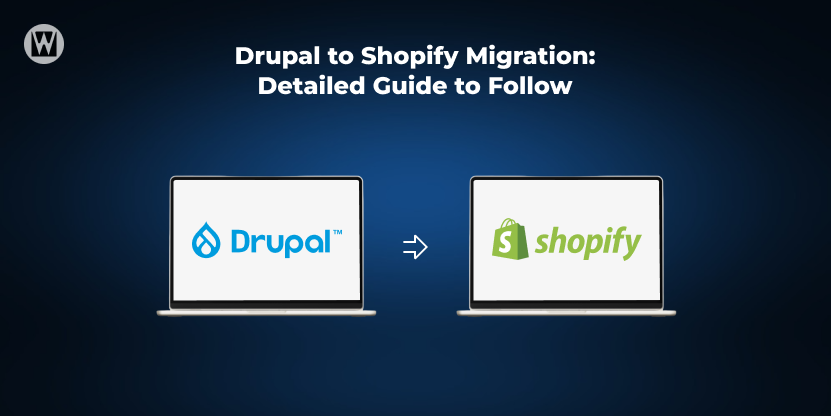Drupal to Shopify Migration: Detailed Guide to Follow

If you’ve been running your store on Drupal, you know it’s powerful—but often too technical for everyday needs. If you find yourself wrestling with code instead of growing your business, it might be time to switch. Shopify offers the ease and speed that modern store owners need, without the constant developer dependency.
In this guide, we’ll walk you through the step-by-step process of Drupal to Shopify migration, stripping away the jargon and sharing key tips from the WebyKing team to ensure a seamless transition.
Why Should You Migrate from Drupal to Shopify?
If you’ve been following eCommerce trends lately, you’ve probably noticed the same thing everyone else has — Shopify is everywhere. From small homegrown brands to big brands using Shopify, everyone seems to be moving their stores to Shopify, and for good reason. It’s modern, reliable, easy to use, and built with growth in mind.
So why does Shopify keep rising while older platforms like Drupal feel a bit… stuck in the past?
If you’re still managing your store on Drupal, it might be the right time to reconsider your platform choice. Here are some clear, practical reasons businesses switch to Shopify and never look back.
1. No Technical Skills Required
Shopify is made for business owners, not developers. You can customize your store, change designs, add products, and manage sales without touching a single line of code.
Drupal, on the other hand, demands technical knowledge. It’s powerful, but you often need a developer for the simplest changes. Shopify keeps things easy, so you can focus on your sales, not system tweaks.
2. Built for eCommerce, Not Just Websites
Shopify is an eCommerce-first platform, meaning everything inside is designed to help you sell. Payments, product management, checkout, inventory, apps. It’s all built-in and seamless.
Drupal can run an online store, but that’s not its main purpose. You’ll need modules, extensions, and constant adjustments to get the same functionality.
If you’re exploring a platform switch, our Shopify website development services can help you build a store that’s fast, scalable, and conversion-ready.
3. Mobile-Ready by Default
Shopify themes are automatically mobile-responsive. No coding. No extra setup. No worrying about how your store looks on different screen sizes.
With Drupal, making your site mobile-friendly often means custom development which means more time, more cost, and more maintenance.
4. Speed & Scalability That Actually Grow With You
Whether you have 10 products or 10,000, Shopify handles growth smoothly. Traffic spikes? Seasonal rush? Flash sales? Shopify can take it.
Drupal is flexible, but scaling requires server management, optimization, and technical adjustments — things most store owners would rather avoid.
5. Security Requirements
Shopify handles major security tasks for you:
- SSL certificates
- PCI compliance
- Server monitoring
- Automatic patches
With Drupal, you are responsible for updates and security fixes. In today’s world, where security risks change daily, Shopify’s hands-off approach is a huge relief.
Shopify is built for the future of eCommerce — fast, secure, scalable, and unbelievably easy to manage. If you’re planning to migrate from Drupal to Shopify, you’re making a smart long-term decision. You save time and money, reduce maintenance, and get a platform designed to help you grow.
For a detailed breakdown of why this switch is worth it, check out our guide: Why You Should Migrate to Shopify.
What to Do Before Starting Your Drupal to Shopify Migration
Backup and Clean Your Drupal Store
Before touching anything, secure your data:
- Take a full backup of your Drupal site (database + files).
- Clean your catalog: remove old products, inactive customers, outdated categories, and test orders.
- Export core data (products, customers, orders, pages) into CSV/XLS for reference.
Why: Ensures you don’t migrate junk data or lose anything important.
Prepare Access & Credentials
Make sure you have:
- Drupal admin login
- FTP/SFTP access (for migration bridge files if using tools)
- Full Drupal admin URL
- Audit of custom modules or content types
Why: Shopify doesn’t understand Drupal’s structure, so proper access helps map everything accurately.
Set Up Your Shopify Store
Prepare your Shopify environment:
- Create your Shopify store (even a trial works)
- Pick a theme matching your brand or future vision
- Disable customer notifications temporarily
- Remove any default/sample data Shopify added
Why: A clean environment prevents errors during import.
Choose Your Migration Method
Options:
- Automated Tools (Cart2Cart, LitExtension, Matrixify) → Best for large catalogs, customers, orders, reviews, and CMS pages.
- Manual Migration → Suitable for very small stores or highly custom needs.
- Agency-Assisted Migration → Ideal for SEO-heavy or highly customized stores.
Why: Choosing the right method avoids data loss and saves hours of cleanup.
How to Migrate from Drupal to Shopify?
Migrating from Drupal to Shopify may feel overwhelming, but with the right steps, it’s easier than you think. Here’s how to make your migration smooth and error-free.
Step 1: Connect Drupal to Shopify
Before migrating, establish a clear connection between your Drupal store and Shopify, depending on the migration method you choose:
1. Using a Migration Tool (Automated)
- Select Drupal as the Source Store in the tool.
- Upload the migration bridge file to your Drupal root folder.
- Install any modules required by the tool.
- Select Shopify as the Target Store.
- Install any Shopify migration app if needed.
Why: This allows safe extraction of products, customers, orders, and pages without manual intervention.
2. Manual Migration
- Export all required data from Drupal (products, customers, orders, pages) in CSV/XLS format.
- Prepare Shopify import templates for each data type.
- Map fields manually between Drupal exports and Shopify templates.
Why: Manual mapping ensures control over each data element, useful for small stores or custom data needs.
3. Agency-Assisted Migration
- Provide your Drupal access and Shopify store details to the agency.
- Share any custom module information, special content types, or SEO considerations.
- The agency will handle connecting both platforms and ensure accurate data transfer.
Why: Agencies manage complex stores, SEO preservation, and custom requirements efficiently.
Step 2: Select the Data to Transfer
Decide what to migrate:
- Products (titles, descriptions, prices, variants, images, SEO)
- Product categories
- Customers + addresses
- Orders + statuses
- Reviews
- Blog/CMS pages
- Coupons & media files
Why: Shopify needs explicit instructions for data import.
Step 3: Map Your Data Correctly
Ensure proper mapping:
- Drupal categories → Shopify collections
- Product variants
- Customer groups → Shopify tags
- Order statuses → Shopify equivalents
- Enable “Preserve IDs” if supported
Why: Prevents broken store structure and SEO issues.
Step 4: Enable Additional Options
Consider turning on:
- 301 redirects
- Migrating product description images
- Migrating customer passwords
- Migrating blog URLs
- Clearing Shopify data before import (optional)
Why: Saves time on post-migration fixes.
Step 5: Run a Demo Migration
- Migrate a small set of products, customers, and orders
- Review the structure, URLs, and images on Shopify
Why: Helps spot mapping or formatting issues before full migration.
Step 6: Run the Full Migration
- Start the full migration after demo is approved
- Keep browser open and avoid editing Shopify
- Wait until all entities are transferred
Why: Interruption can corrupt data.
Step 7: Review & Fix Your Shopify Store
- Check product listings, variants, images, SKUs
- Review collections and CMS pages
- Verify customer data and order history
- Adjust theme styling
Why: Migrated data usually needs polishing.
Step 8: Set Up 301 Redirects
- Redirect old Drupal URLs to Shopify URLs
- Use Shopify’s built-in redirects or apps like Easy Redirects
Why: Protects SEO rankings and avoids 404 errors.
Step 9: Test Everything Before Launch
- Add to cart, checkout, payment gateways
- Shipping rules, taxes
- Mobile responsiveness, page speed
Why: Ensures a smooth customer experience.
Step 10: Launch Your Shopify Store
- Connect domain and switch DNS settings
- Enable customer email notifications
- Publish theme
- Optionally keep Drupal for reference
SEO Tasks You Must Complete After Your Drupal to Shopify Migration
After your new Shopify store goes live, it’s crucial to fine-tune your SEO to protect your rankings and ensure smooth search engine visibility. Make sure you complete these key tasks:
- Submit your new sitemap to Google Search Console so Google can quickly discover and index all your new Shopify URLs.
- Test your structured data to ensure product schema, breadcrumbs, and other rich results are implemented correctly.
- Run an SEO audit using tools like Ahrefs or SEMrush to identify missing metadata, content gaps, or issues created during migration.
- Fix broken URLs and monitor your traffic to catch any 404 errors early and ensure your redirects are working as expected.
Why this matters: Post-migration SEO is essential to maintain your search visibility, avoid ranking drops, and ensure your new Shopify store performs at its best.
How Webyking Helps to Migrate From Drupal To Shopify?
At WebyKing, we are experts in seamless website migration services from Drupal to Shopify. With years of experience and a team of professionals on both platforms, we ensure your migration process will be smooth and hassle-free.
We have covered everything from moving your product categories to customer data to ensuring your SEO performance is preserved throughout the migration process. Whether you are looking for a fully managed migration or need help with certain aspects, WebyKing has the expertise to handle it quickly, so you can focus on your business growth without getting concerned about technical aspects.
So what are you waiting for? Let us help you make the switch to Shopify with confidence.
FAQs About Migrating from Drupal to Shopify
1. Can I migrate my Drupal blog posts and custom content types to Shopify?
Yes, you can migrate blog posts and custom content types, but Shopify may require restructuring since it doesn’t support complex content types natively. You’ll often need apps or custom development to map them correctly.
2. Will my SEO rankings drop after migrating from Drupal to Shopify?
A temporary fluctuation is normal, but maintaining URLs, redirects, metadata, and structured data helps preserve rankings. With proper SEO migration steps, long-term impact is minimal.
3. What data doesn’t transfer automatically during a Drupal to Shopify migration?
Custom fields, complex content types, advanced taxonomies, SEO modules data, and customer passwords don’t transfer automatically. These usually require manual handling or custom migration scripts.
4. Do I need developer help, or can I migrate from Drupal to Shopify on my own?
Basic migrations can be done using tools or apps, but full migrations with custom content, SEO assets, and layouts typically require a developer or Shopify migration expert for accuracy.
5. Can I run both Drupal and Shopify simultaneously until the migration is complete?
Yes, you can keep Drupal live while building your Shopify store. Many businesses run both in parallel to test the new setup without interrupting their existing website.
6. Can I import products from Drupal to Shopify?
Yes. You can import products from Drupal to Shopify.

Ravi Makhija, the visionary Founder and CEO of WebyKing, is a seasoned digital marketing strategist and web technology expert with over a decade of experience. Under his leadership, WebyKing has evolved into a premier full service web and marketing agency, delivering innovative solutions that drive online success. Ravi’s deep understanding of the digital landscape combined with his passion for cutting-edge technologies empowers him to consistently exceed client expectations and deliver results that matter.
















